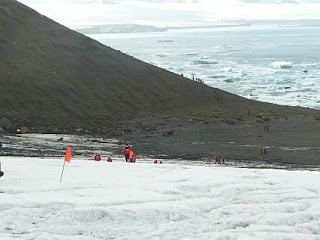Antarctica
Day 4
FYI. Sunrise is at 4.40am and sunset was at 9.15pm. As we
are not that far south (63° 35’S), the night is dark.
We woke up to a white out with visibility of only 100m,
but as our group, the second group to leave the boat, was not scheduled to
depart on our excursion to Heroina Point on Danger Island until 8.15am we were
not too worried. During breakfast it was announced our departure would be
delayed until 8.30am (the other group left at 7am).
Due to the fog and low visibility the zodiacs went out in
groups of three. Danger Island is a major breeding ground for the Adelie
penguin with over 300,000 nests. That meant there were over 1 million penguins
in residence when we visited (ie 300,000 x2, plus single birds plus, at least
one chick per nest).
As our trip to the island progressed, the fog dispersed
and we had a very enjoyable trip through ice blocks and ice frazil, viewing a
large leopard seal up very close (2m) whilst it lay on a small ice sheet, with
the remains of its penguin breakfast nearby. We then went to a rocky beach
where we landed and we were able to see thousands of Adelie penguins up close.
The penguins were not just around the water’s edge but up to 150m up the side
of the island. We also noticed that the chicks on this island were not as
developed as those we saw yesterday afternoon – they had more down. Lesley saw
(and photographed) one penguin which had been attached by a seal and was
missing a large section of feathers on its belly and side, but was still very
much alive.
As we returned to the ship the fog again appeared and the
ship was not visible until we were only a few hundred metres away.
 |
| leopard seal |
 |
| this chap came off second best with a leopard seal perhaps. Huge chunk missing from his torso. |
Once everyone
was back aboard, the ship headed back to the Antarctic Sound and Brown Bluff
for our afternoon excursion. This was our first opportunity to step onto the
continent itself (up to now it has been islands and an icefloe).
At this morning’s Recap (of this morning) and Briefing (for
this afternoon and tomorrow‘s excursions) we were told this morning’s
temperature was 0°C but when wind chill is taken into consideration, about
-10°C. A bit cold, even with thermals
and inner and outer snow gear.
For those interested, the zodiacs are powered by a single
60hp four-stroke Yamaha outboard engine.
There are also a couple of centre console zodiacs with twin 60hp
engines. Each zodiac takes 10 passengers, five sitting on each side and carries
a ship-locating beacon. We wear our zodiac life jackets even when we are on
land, only taking them off when we return to the ship.
The ship arrived at Brown Bluff in bright sunshine and 4°,
and dropped anchor about 500m from shore. We have experienced, on this cruise,
all weather conditions except blizzard. Our zodiac trip from the ship to shore
was again through ice. Once on the stony beach we climbed along a bluff (rubble
scree barely covering ice underneath) and then across a flat to the base of a
glacier which we then ascended for a couple of hundred metres (they didn’t want
us going too far and falling into a hidden crevasse!). The glacier was melting
and there were little fast-flowing streams and ponds all over.
 |
| walking onto the glacier |
 |
| face of the glacier |
Afterwards we went to the base of the glacier and then
went to look at another penguin rookery. This was a much smaller one than
previously seen. There were both Gentoo and Adelie penguins here. It was funny
watching the chicks of both chasing their parents to be fed. One Gentoo parent
ran into the water to force the two adolescent chicks to follow, which both did
– briefly! Chicks don’t like the water. These two will have to do it shortly as
they’re nearly adult and will have to care for themselves.
We returned to the landing spot to return to the ship. During
our stay on land (mainland Antarctica) the ship had moved a further kilometre
out to sea as it had started to get blocked in with ice.
After dinner we went to a singing/dancing show. [During
the afternoon Lesley went to a piano recital of Chopin’s music given by the
ship’s concert pianist. It was lovely! He is a concert pianist in real life –
this is a great way to get paid and see an amazing part of the world at the
same time!]
 |
| boots lining the hallways |





















































